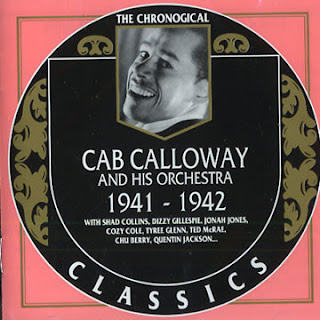The Uncollected Stan Kenton and his Orchestra - Volume 2
The Uncollected Stan Kenton and his Orchestra Volume 2 is the companion to volume 1 and contains more material from the MacGregor transcriptions recorded between mid-August and September 19, 1941. These contain some of the earliest recordings of the Kenton orchestra so the band was still developing its own sound. Whereas the brass would dominate in later bands, there are as many brass as there are saxophones here. The five saxophone sound was relatively new at the time and Kenton took full advantage of this fact. Otherwise, there are some hints of the Kenton tendency, but at times the band sounds rather generic.
Not that the band doesn't swing, when they do it's strong, but sometimes it feels like the music is over-arranged or overthought out. This is still the laboratory phase. There is definitely a movement by Kenton towards expanding the possibilities of Swing music by having unusual harmonies and extended pieces, as heard on the four-part "Suite for Saxophones".
The other issue with the music is the rather faceless band, especially considering the talent that would grace the band in the future. Trumpeter Chico Alvarez, originally from Montreal, has the strongest and most convincing sound. He's influenced by Louis Armstrong and Bunny Berigan, and his solos tend to occupy the instrument's upper register (but not as high as Kenton bands would be known for). Bassist Howard Ramsey is the most recognizable name here, later releasing a series of records under his own at his own club in Los Angeles. But Red Dorris' Coleman Hawkins-influenced sound on tenor saxophone and Jack Odrean light sounding alto sometimes sound pedestrian. Dorris' has a good sound but perhaps it's the material they're soloing on, but it feels like they are not as distinctive and are one-dimensional players playing the same solo every time.
Part of the issue is the material which is not that strong. More than anything else, it's more about the arrangements so the tunes tend to fall by the wayside. Also everything is just so short (six of the sixteen tunes are under two minutes long) that everything just whizzes by and easy to sing melodies are just as easy to forget. Probably the biggest crime is the rhythms which are often bland and uninventive. I mentioned the persistent consecutive off-beats that marked the first volume, here I noticed a tendency to accentuate the downbeat. Especially on ballads, where beats one and three are emphasized in the horns, it just makes the music so heavy and weakens the flow and the swng. Uptempo numbers are better, but the short and repetitive rhythmic phrases, common to the era, are burdened with unimaginative rhythms: "Low Bridge", for example, has a prominent Charleston rhythm throughout the piece.
 |
| 2001 UK CD |
Written by Kenton, this suite features the saxophones from beginning to end and the brass is absent throughout. He likes chromatic harmonies and so there is some unusual harmonic movement especially with his use of half-step panning leading to the b2 dominant chord---effectively a tritone substitution, a bebop device that is heard here. With Kenton, it is not for improvisers, and instead seems to be a method of creating drama. A common texture throughout is having the two altos on the melody while the lower saxes play pads. The sax solis are nice, especially on "Opus in Pastels", but the vibrato is intense, otherwise the section sounds good.
Overall the four parts, which range from slow to medium, is an early attempt by Kenton to bridge the gap between classical and jazz. Unfortunately it sounds like neither and generally sounds more like a writing exercise as the texture is unchanging throughout, especially on the longer solis on "Etude for Saxophones" and "Tribute to a Flatted Fifth". These titles also indicate Kenton's propensity towards 'progressive jazz'.
There are some nice chromatic and unusual harmonic twists which make the band sound unique. Besides the tritone substitution, dominant chords moving chromatically is another favorite technique as heard on "Hold Back the Dawn", "Suite for Saxophones", and "Shuffling the Chords" even features some crunchy dissonance at the end of the bridge.
 |
| Alfred 'Chico' Alvarez (1920-1992) |
These recordings are mostly significant for the career and development of Stan Kenton and his music, He had previously played in Vido Musso's band which was based on the powerhouse style of Jimmie Lunceford. Kenton adopted that sound (along with some of the musicians that band), but his first recordings for Decca, made during this period, were not successful. While it's easy to hear why, the band was developing its own identity and if nothing else, did not sound like any other band of its day with the emphasis on saxophones. Claude Thornhill was also dipping into the classical well for ideas in jazz at this time, but Kenton's style is harder. There would be better music in the future, but the seeds are here.




Comments
Post a Comment